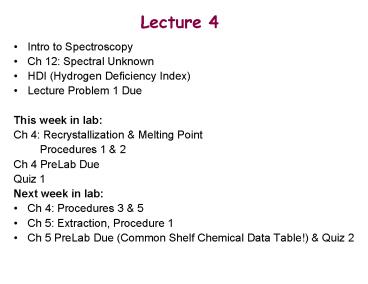Intro to Spectroscopy - PowerPoint PPT Presentation
1 / 13
Title:
Intro to Spectroscopy
Description:
Ch 5: Extraction, Procedure 1. Ch 5 PreLab Due (Common Shelf Chemical Data Table!) & Quiz 2 ... MS - make up sample and submit sample for analysis ... – PowerPoint PPT presentation
Number of Views:58
Avg rating:3.0/5.0
Title: Intro to Spectroscopy
1
Lecture 4
- Intro to Spectroscopy
- Ch 12 Spectral Unknown
- HDI (Hydrogen Deficiency Index)
- Lecture Problem 1 Due
- This week in lab
- Ch 4 Recrystallization Melting Point
- Procedures 1 2
- Ch 4 PreLab Due
- Quiz 1
- Next week in lab
- Ch 4 Procedures 3 5
- Ch 5 Extraction, Procedure 1
- Ch 5 PreLab Due (Common Shelf Chemical Data
Table!) Quiz 2
2
Organic Chemistry From Yesterday to Today
- Late 1700s Atomic Theory
1800s Organic Structural Theory - Combustion
Analysis - Functional Group Tests
1900s Synthesis and Analysis
Today Automated Synthesis Spectroscopic
Analysis
3
Main Types of Spectroscopy
- Each type of spectroscopy has its value in
determining/confirming the structure of a
compound. Spectroscopy allows us to see the
molecule. - NMR (Nuclear Magnetic Resonance)
- Aids in the determination of bond connectivity
within a molecule the pieces of a molecule - IR (Infrared)
- Confirms the presence of functional groups within
a molecule - MS (Mass Spectrometry)
- Determines the mass of a compound
- Also aids in the determination of pieces of the
molecule
4
Types of Spectroscopy
- NMR (Nuclear Magnetic Resonance Spectroscopy)
- Uses radio waves (electromagnetic radiation)
- Interacts with samples nuclei in the presence of
a magnet - Effect nuclei flip and relax (known as
resonance) - IR (Infrared Spectroscopy)
- IR radiation
- Interacts with molecule as a whole
- Effect bond vibrations within molecule
- MS (Mass Spectrometry)
- No radiation used
- Interacts with and destroys molecule fragments
molecule - Effect creates ions and neutral fragments of
molecule
5
1H NMR Spectrum of Ethanol
CH3CH2OH
ppm
6
IR Spectrum of Hexanol
Transmittance
Wavenumber (cm-1)
7
Mass Spectrum of Phenetole
94
Intensity
122
77
m/z (mass to charge ratio)
8
Ch 12 Spectral Unknown
- Be sure not to mix this unknown up with the
Recrystallization Ch 4 unknown! - 1H NMR spectrum - run and acquire data
- IR spectrum - run and acquire data
- MS - make up sample and submit sample for
analysis - Be sure to get your spectral data signed and
dated by the TA. - Sign up for time now.
- Make up your samples during your scheduled lab
period. Refer to the back inside cover of the
Lab Guide for sample prep instructions. - Store samples in the Instrument Room - be sure to
label your samples! - Use melting point to get a list of possible
unknowns (website). - Note
- Progress Check is due the week of March 20.
- Final Report is due the week of April 24.
9
HDI (Hydrogen Deficiency Index)
- HDI
- Determines if a multiple bond or ring is present
in a molecule - Need molecular formula to determine HDI
- Good tool to use when determining possible
structures of an unknown - Coupled with spectral data - process of
elimination from possibilities list!
HDI Calculation 1. Determine the Hydrogen
Deficiency (HD) 2. Determine HDI HDI HD/2
10
Hydrogen Deficiency
- Hydrocarbons (C H)
- Example Determine the HDI of a compound whose MF
is C5H10. What are possible structures for this
compound?
Calculation (in class)
11
HDI
- Hydrocarbons (C H)
- Example Determine the HDI of a compound whose MF
is C5H10. What are possible structures for this
compound?
The possible structures of the compound are
12
Nitrogen and HDI
- Nitrogen Organic Compounds (C, H N)
- Example Given a MF of C4H7N, what is the HDI of
this compound?
Rule Count N as NH and rewrite formula
C4H6NH Calculation (in class)
Possible Compounds
13
Oxygen and HDI
- Oxygen Organic Compounds (C, H O)
- Example Given a MF of C6H12O, what is the HDI of
this compound?
Rule MF stays the same (unlike nitrogen) Oxygen
doesnt affect the HDI calculation Calculation
(in class)
Possible Compounds































